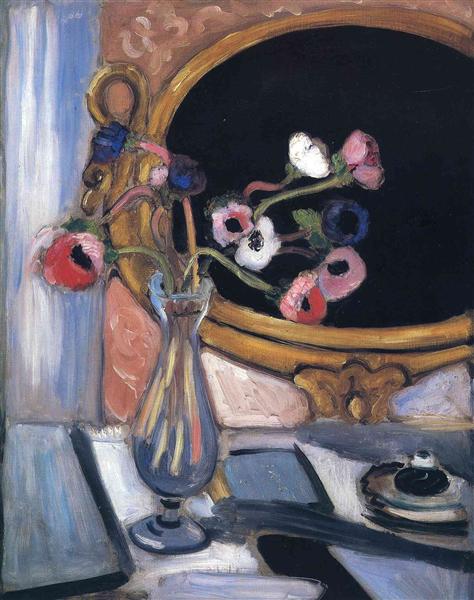Description
The work "Anemone and Mirror" by Henri Matisse, created in 1920, is a vibrant and bold celebration of color and form, in line with the characteristic style that Matisse developed throughout his career. This painting encapsulates the essence of the complex simplicity with which the artist approached the everyday world, filling it with a liveliness that is perceived without concessions in this composition.
The first observation one makes when contemplating "Anemone and Mirror" is the masterful use of color, a fundamental aspect of Matisse's work. The warm tones of the anemones, with their explosion of reds, oranges, and pinks, contrast sublimely with the dark background of the mirror that not only serves to reflect but also to frame and highlight the vitality of the flowers placed in the foreground. This contrast creates a visual dynamic that keeps the viewer's attention focused on the heart of the composition.
The mirror, besides being a physical and representational element, plays a crucial role in the understanding of the painting. In the mirror, the anemones refract into a duplicated reality, creating a sense of depth and an additional dimension in which the viewer can get lost. This duplicity introduces a reflection on perception and reality, recurring themes in Matisse's works.
The simplicity of the elements in the painting is contrasted with the meticulousness in the arrangement of the details. The green leaves, with their sinuous and freely arranged shapes, confer balance and movement, softening the rigidity of the rectangular frame of the mirror and the table on which the flowers rest. This relationship between structure and freedom is a constant in Matisse's work and is clearly evidenced in this painting.
The background of the work, although seemingly simple, is a careful choreography of blue, black, and purple tones that do not distract but rather emphasize the anemones and the mirror. Matisse's refusal to use a negative space without intention demonstrates his mastery in keeping every corner of the canvas with purpose and meaning.
It is important to understand "Anemone and Mirror" in the broader context of Henri Matisse's work. Although this painting does not have human characters, the prominence of the still life and the incorporation of common objects are in the same thematic line as many of his other pieces. Throughout his life, Matisse sought to simplify forms without losing emotional impact and visual dynamism. This painting is a perfect example of how he achieved that balance, preserving the intensity of life in seemingly simple art.
Reflecting on Henri Matisse's legacy and his contribution to Fauvism and modern art in general, "Anemone and Mirror" occupies a special place as an ode to his virtuosity with color and form. The apparent delicacy of the flowers is juxtaposed with the solemnity of the mirror, providing the viewer with a rich and complex aesthetic experience, both accessible and profound. The work remains a testament to Matisse's ingenuity and ability to capture the extraordinary in the ordinary, continuing to inspire generations of artists and art lovers alike.

